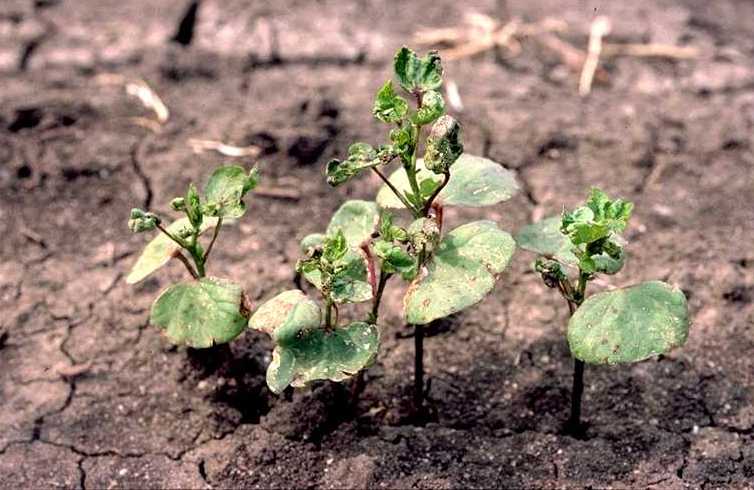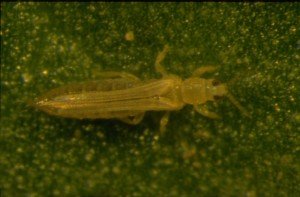
C. Mares (CSIRO)
Just when you thought things were going along pretty well, something else pops out of the woodwork to bring you back down to earth. Some cotton consultants and their grower clients are concerned about the high numbers of thrips in their young cotton seedlings. Are they are problem? Do we need to control them?
Essentially, unless seedling terminals are dying, the damage to leaves, which causes distortion and cupping, is largely cosmetic and in most cases will not compromise yield and maturity. Only extreme populations (70 thrips per plant) caused maturity delays in excess of 7 days. Cool weather can exacerbate thrips damage, while warmer weather will help plants grow away from damage quickly – hence risks are higher in cooler regions and much lower in warmer regions.
Thrips are also important predators of spider mites, feeding on mite eggs as a source of protein, so it is important to weigh their value as predators against potential risk of yield loss or delay.
Which thrips?
Species infesting seedling cotton are tobacco thrips, Thrips tabaci, the most common, and tomato thrips, Frankliniella schultzei. Adults thrips are small, cylindrical insects (<1.5 mm long) with two pairs of narrow wings fringed with long hairs. Thrips tabaci is usually a pale straw colour while F. schultzei is typically almost black. Larvae of both species (< l mm long) are yellow and wingless.

L. Wilson (CSIRO)
The western flower thrips (WFT), Frankiliniella occidentalis is a recent exotic invader also found in cotton regions. It is similar in appearance to F. schultzei but paler, making it easy to distinguish from F. schultzei but hard to distinguish from T. tabaci. WFT causes similar damage to cotton seedlings and also eats mite eggs. It is resistant to a range of insecticides, including many organophosphates and carbamates.
What are we finding?
Most thrips collected last week on cotton seedlings on the Darling Downs were T. tabaci, but low numbers of F. occidentalis were present. The numbers of thrips nymphs were very low, indicating effective control (see below). The presence of high populations of adult T. tabaci where either granular insecticides or seed dressing have been used suggests there are constant influxes of adult thrips moving in from cereals and weeds (see below).
Thrips Thresholds
Due to the capacity to recover from some damage, thresholds for thrips must include both pest abundance and damage levels – which should both be exceeded before control is warranted.
From planting to flowering (1 flower per metre)
Adults and larvae per plant 10
and
Damage (reduction in leaf area) 80% (leaves less than 1 cm in length)
Control
Seed dressings can reduce early damage but will degrade over 14 to 21 days post planting (indicted by the presence of thrips larvae). By then leaf area should be sufficient for above-ground applications of systemic insecticides to be effective if necessary. Systemic granular insecticides, applied at planting, provide longer control, but in some districts they are not necessary for thrips control due to low numbers or good growing conditions.
If using seed dressings or granular insecticides be aware that adult thrips will continue to be found in the crop as they move from cereals and weeds. These adults will feed and die, causing no damage. The best indicator of declining control is the presence of thrips larvae which indicates that the pesticide is no longer effective.
